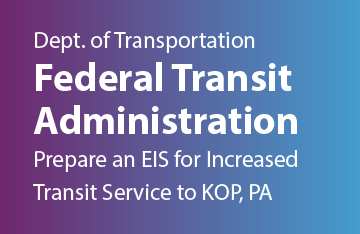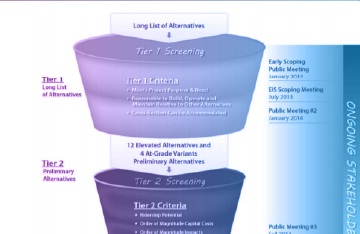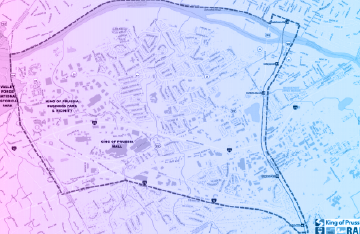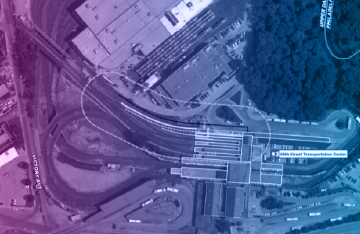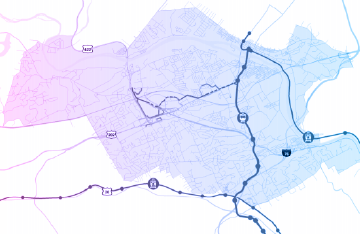
Environmental Impact Statements are required by the National Environmental Policy Act of 1969 (NEPA). A Draft Environmental Impact Statement (DEIS) is a written statement containing an assessment of the anticipated effects (both positive and negative) a proposed alternative may have upon the environment (natural, social, or cultural) leading to the identification of the Locally Preferred Alternative (LPA). The LPA is a route that is found to best meet the stated purpose and need for an alternative, the evaluation criteria of the alternatives analysis, and public input.
The DEIS for the King of Prussia Rail Project (KOP Rail) completed in 2017. In January 2018, the SEPTA board approved the adoption of the recommended Locally Preferred Alternative (LPA) with the North/South design option, which shifted the rail alignment away from residential areas. The LPA is included in Delaware Valley Regional Planning Commission’s regional long-range plan, Connections 2045, and Montgomery County’s Montco 2040 county comprehensive plan.
SEPTA evaluated more than 30 alternatives for a new rail connection between the existing Norristown High Speed Line and destinations in King of Prussia. Six public meetings were held during the Alternatives Analysis and preparation of the DEIS.
The completion of the KOP Rail DEIS and selection of the LPA allowed the Final Environmental Impact Statement (FEIS) to commence in March 2018.
The completion of the KOP Rail DEIS and selection of the LPA allowed the Final Environmental Impact Statement (FEIS) to commence in March 2018.
DRAFT COMPONENTS
-
Purpose and Need
The Purpose and Need statement is the foundation of the NEPA planning process. It provides the rationale and justification for undertaking a major federal investment and forms the basis for the range of alternatives to be studied in the DEIS.
The DEIS defined the purpose of the project is to provide faster, more reliable public transit service that:
- Offers improved transit connections to KOP/Valley Forge area from communities along the existing Norristown High Speed Line, Norristown, and Philadelphia;
- Improves connectivity between major destinations within the KOP/Valley Forge area;
- and Better serves existing transit riders and accommodates new transit patrons.
-
Analysis
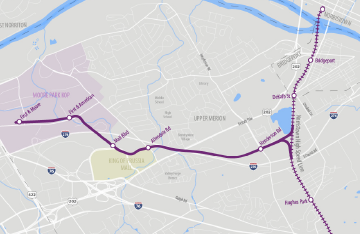
SEPTA evaluated more than 30 alternatives for a new rail connection between the existing Norristown High Speed Line and destinations in KOP. These alternatives were “screened” through a three-tiered evaluation process, which resulted in the selection of the PECO/Turnpike First Avenue alternative with the North/South design option that shifted the alignment away from residential areas as the recommended LPA.
View Alternatives Analysis -
Impacts
The DEIS analyzed and compared the potential positive and negative impacts the alternatives would have on the natural, cultural, and socioeconomic environments. Preliminary mitigation was developed for the unavoidable adverse impacts.
View Potential Impacts -
Involvement
A key element of the alternatives development and evaluation process is input from agencies, stakeholders (individuals with an interest in or potentially affected by the project), and the public. From the beginning of the project, SEPTA engaged agencies and stakeholders, and the public through periodic meetings to discuss issues related to the project and to work toward mutually beneficial solutions.
View DEIS Public Meetings
DEIS Documents
Scroll to browse all of the documents related to the DEIS process.


